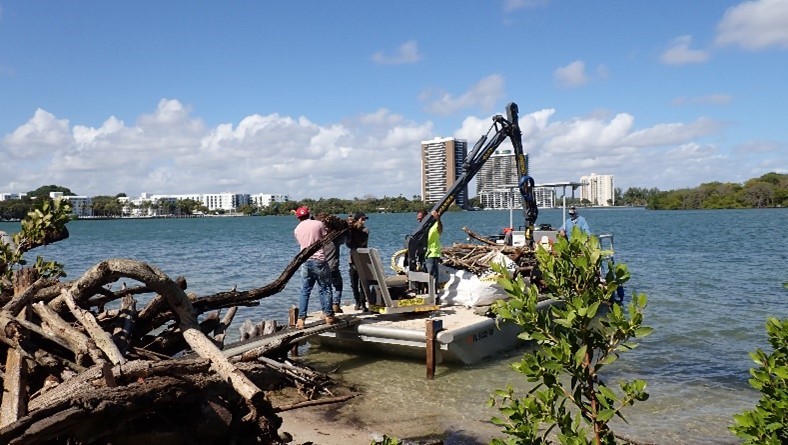- Alex Reed
- AshBritt Environmental
- Bipartisan Budget Act of 2018
- Biscayne Bay
- Biscayne Bay Commission
- Biscayne Bay Task Force
- Bryan Avila
- Daniella Levine Cava Irela Bague
- DEP
- Department of Environmental Protection
- Fish kill
- Florida Department of Environmental Protection
- Hurricane Irma
- Ileana Garcia
- Manatees
- Marine Debris Program
- Miami
- miami dade county
- Miami-Dade Commission District 10
- Miami-Dade County Commission
- Miami-Dade County Department of Environmental Resources
- National Oceanic and Atmospheric Administration
- NOAA
- North Miami
- Rachel Silverstein
- Rebeca Sosa
- Ron DeSantis
- seagrass
- spoil islands

Fifty-six tons. That’s roughly the weight of 40 cars, 13 fully grown hippopotamus and one-third the mass of the Statue of Liberty (not counting its base).
It’s also the total weight of hurricane debris the Florida Department of Environmental Protection recently removed from spoil islands in Biscayne Bay.
Over 46 days, the DEP cooperated with personnel from Miami-Dade County, the cities of Miami and North Miami Beach, and Deerfield Beach-based disaster relief contractor AshBritt Environmental to clear 45 island acres on 13 of the small, artificial islands.
Spoil islands are the remnants of past bay dredging. Many today function as miniature beaches and parks complete with sand, mangroves and seagrape, among other native flora. They attract boaters, jet skiers and other aquatic pleasure seekers — as well as an overflow of garbage and debris.
Workers began at island shorelines and worked inland for up to 100 feet, removing dock and decking lumber, rubber tires, fishing gear, plastic, aluminum cans and materials that can negatively affect water quality, vegetative growth and wildlife health.
“This was an excellent example of what can happen when federal, state, local and private partners work together toward a common purpose,” said Alex Reed, director of the DEP’s Office of Resilience and Coastal Protection.
Funding for the project came through a $100,000 grant from the National Oceanic and Atmospheric Administration’s Marine Debris Program — a small portion of the $18 million Congress earmarked through the Bipartisan Budget Act of 2018 for the assessment and removal of marine debris from Hurricanes Harvey, Irma and Maria.
Much of the debris on and around Biscayne Bay’s spoil islands was left over from Hurricane Irma, a Category 5 storm that swept across Florida in 2017 to cause an estimated $50 billion in damage, making it the costliest hurricane in state history.
According to a DEP press note, the recent cleanup effort is the first of its kind in decades. Spoil islands in Biscayne Bay were last restored and enhanced in the 1990s and early 2000s through a state-funded project by the Miami-Dade Department of Environmental Resources Management.
Efforts planned for the future include the removal of submerged debris and derelict vessels from the spoil islands.
Smaller restorative projects have occurred since 2015 through the Biscayne Aquatic Preserves’ Adopt-an-Island program and in weekly trash pickups by the county.
A subtropical lagoon spanning 60 miles on the southeast corner of the Florida peninsula, Biscayne Bay has been a subject of concern among environmentalists, elected leaders and locals disturbed by increasingly frequent algal blooms and fish kills.
Those worsening conditions — as well numerous sewage spills, the widespread disappearance of seagrass and a record number of manatee deaths — prompted many environmental scientists, including Miami Waterkeeper Executive Director Rachel Silverstein, to declare the waterbody has reached a “tipping point.”
A Miami-Dade grand jury concluded in August 2019 that the bay was in a “precarious balance” due to three key contributors: sewage contamination, excess nutrients, and pollution and littering, including marine debris, plastics and sediment flowing from canals into the bay.
Local and state officials took note. After a mass marine life die-off in August 2020 that killed more than 27,000 fish, Miami-Dade Mayor Daniella Levine Cava appointed Irela Bagué to serve as the county’s first chief bay officer. Bagué, who owns and operates a public affairs firm focused on environmental issues, previously chaired the county’s Biscayne Bay Task Force, which among other things recommended the creation of the chief bay officer position.
A more permanent successor to the task force came into being in early June 2021, when Gov. Ron DeSantis signed legislation setting up a Biscayne Bay Commission to help rehabilitate the area. The nine-member Commission’s purpose is to “unite all governmental agencies, businesses, and residents in the area to speak with one voice on bay issues; to develop coordinated plans, priorities, programs, and projects that might substantially improve the bay; and to act as the principal advocate and watchdog to ensure that bay projects are funded and implemented in a proper and timely manner.”
Both of the measure’s prime sponsors — House Speaker Pro Tempore Bryan Ávila and Sen. Ileana Garcia — hail from Miami-Dade County, and Garcia in particular has prioritized the bay and other water quality issues during her time in the Legislature.
In the 2021 Legislative Session, Garcia secured $20 million for projects related to the bay and $16 million for coastal resilience grant funding for South Florida. After Sine Die, she met with Bagué to discuss further action, including seeking additional funding to help address pollution specific to spoil islands.
Several municipalities in Miami-Dade, including Miami and North Miami Beach, hold deeds to the islands and are responsible for general cleanup duties, including weekly trash pickups. But Garcia’s office said much more still needs to be done to prevent erosion and physical damage to the islands that grounded and tethered vessels are causing.
More generally, Miami-Dade Commissioners are taking steps to keep man-made debris out of the bay. On July 19, the board approved an ordinance by Rebeca Sosa to provide a significant hike to the county’s water pollution fines, in some cases raising penalties more than tenfold.



